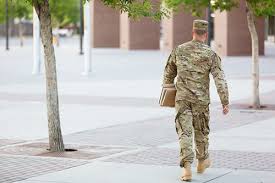
There are several factors that go into successfully teaching, and communicating to student veterans. Many may think that military veterans learn, and communicate exactly like their civilian peers. However, subtle differences are present. Veterans that have been honorably discharged from military service are entitled to the GI Bill, which awards them 36 months of paid tuition and living expenses. But, most veterans choose not to use the benefit, or do not use it’s entirety. How could this be? Well, some of the issues veterans face that deter them from entering post-secondary education are: extensive VA paperwork to secure the GI Bill, learning disabilities attributed from military-related trauma, self-identity issues, adjustment to new social norms, and fear of unstructured organizations.
Veterans are a great resource for educators and the classroom (Lighthall, 2019). Their experiences are unlike many of their peers, and they have seen things and done things only seen in movies or read in books. Their first hand experiences provide a diverse perspective of world issues that may be beneficial in many classroom settings. There is, however, underlying difficulties they may have with this new career change. Many veterans joined the military prior to their 21st birthday, and military life has become so ingrained into their persona during this important developmental stage, that they may have difficulty coping with new social environments. As these students are likely to be the oldest in their class and it is unlikely that they will know anyone from high school or the military joining them at the same school, they may feel alone and isolated. They have little common interests with their peers, and the lack of rank structure may seem confusing. For many student veterans, this is the first time they have experienced true freedom, and the first time they are free to make choices on their own. Veterans also may find difficulties coping with classroom dynamics where egalitarian structures are becoming more common, and participation is greatly encourage. Coming from a system of strict rules and regulations to a place of equality and sharing can, in fact, come off as chaotic for student veterans.
I will be the first to admit as a veteran myself on my first day of class after the military, I jumped out of my seat and stood at parade rest as soon as the teacher entered the classroom, as if he was a commissioned officer. I tried to play it off and went to the bathroom, but I had been out of the military for about 4 months and would need to fight the impulse to stand for my superiors when they entered the classroom. A life of order under a hierarchical chain of command can be hard to break, but by understanding the needs of student veterans can help their transition from service member to student.
Most veterans will not reach out or communicate to teachers or other students their needs or problems. This may be due to them trying not to appear weak or needy. Reaching out to veterans to see if they require any assistance is the best way to pull this information from them. Many times due to TBI’s or other service related injuries they may require remedial instruction for them to grasp certain concepts. Remember also, that many have not been in a traditional classroom for 4+ years. Try not to put the student on the spot if they are standoffish or quite, allow them to sit towards the back of class, and communicate to them that educators are their to assist them with their coursework – and do this often.
References
Bart, M. (2012). “Helping Student Veterans Succeed in the Classroom,” Faculty Focus Newsletter. Magna Publications.
Lighthall, A. (2014). “Ten Things You Should Know about Today’s Student Veteran,” Thought and Action, a publication by the National Education Association, pp. 80-89.
Military and Veteran Student Services, San Jose State University (2014). “Teaching Student Veterans.”